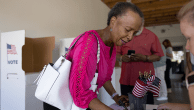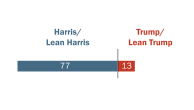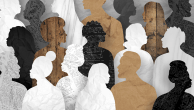It may surprise anyone following the charges of racism that have flared up during the debate over President Obama’s health care proposals, but a survey taken this summer found that fewer people perceived there are strong conflicts between blacks and whites than saw strong conflicts between immigrants and the native born, or between rich people and poor people.
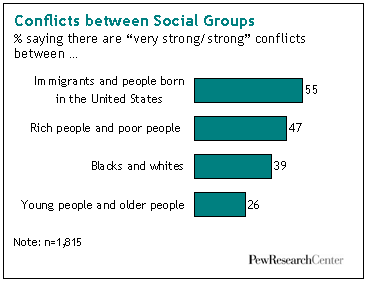
A majority (55%) of adults said there are “very strong” or “strong” conflicts between immigrants and people born in the United States. Nearly as many — 47% — said the same about conflicts between rich people and poor people, according to a nationally representative survey by the Pew Research Center Social & Demographic Trends project.
The survey found that about four-in-ten (39%) believe there are serious conflicts between blacks and whites, and only a quarter (26%) see major generational divisions between the young and old.1
The findings come at a time when discussions about the role of racism in American society has featured heavily in media coverage of Obama’s presidency — triggered first by the arrest in July of a prominent African-American Harvard professor in his own home, and more recently by the assertion by former President Jimmy Carter that much of the opposition to Obama’s policies is racially motivated. The Pew Research survey was conducted from July 20 to Aug. 2, shortly after the Harvard incident but before President Carter’s recent comments.
Different Groups See Different Levels of Conflict
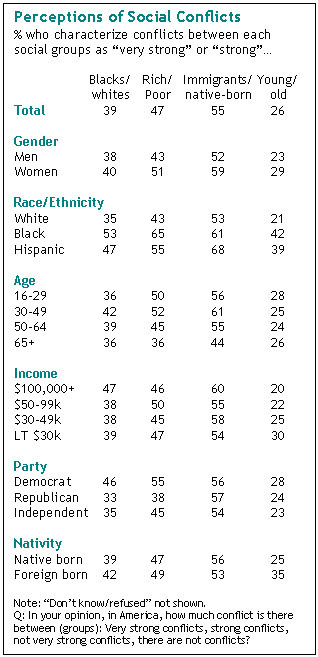
The survey found some notable demographic patterns in the public’s perceptions of social conflicts. For example, blacks, Hispanics and women are significantly more likely than whites and men to say major conflicts exist between groups in at least three of the four areas tested in the survey. Blacks, in particular, consistently see more social conflict than do other demographic groups. But not even blacks believe that racial conflict is the most prevalent kind of conflict in the country today. A bare majority of blacks (53%) say there are “very strong/ strong” conflicts between blacks and whites. At the same time, nearly two-thirds of blacks (65%) say there are significant conflicts between the rich and poor, and 61% say there are significant conflicts between immigrants and the native born. Blacks also are twice as likely as whites to see major generational conflicts (42% vs. 21%).
The pattern is mixed among other groups. Older adults are significantly less likely than younger people to see strong conflicts between immigrants and native born and between the rich and the poor, but just as likely to see serious generational differences and racial disputes.
Similarly, half of all Democrats (46%) but a only third of Republicans (33%) say there are serious conflicts between blacks and whites. The partisan perceptions gap is even bigger on perceptions of conflicts between the rich and poor: a 55% majority of Democrats see very serious or serious conflicts between haves- and have-nots, compared with 38% of Republicans. At the same time, there is no significant difference by party affiliation in perceptions about conflicts between immigrants and native born or between the generations.
Social Conflict in American Life
To measure perceptions of social conflict, a total of 1,815 persons age 16 and older were interviewed July 20-Aug. 2, 2009. Respondents were asked in separate questions “In all countries, there are differences or conflicts between different social groups. In your opinion, in America, how much conflict is there between…” blacks and whites, the poor and the rich, young people and older people, and immigrants and people born in the United States. Respondents were then given these answer options: “very strong conflicts, strong conflicts, not very strong conflicts, there are not conflicts” for each domain.2
Disagreements between immigrants and native-born Americans emerge as the most prevalent and serious type of social conflict among those tested in the survey. A clear majority (55%) of adults say there are “very strong” or “strong” conflicts between these groups, including 18% who say there are “very strong” conflicts and 37% who describe them as “strong.”
Hispanics in particular see serious clashes between these groups: nearly seven-in-ten (68%) say there are major conflicts between immigrants and the native born, a view shared by half of whites (53%) and six-in-ten blacks (61%).
At the same time, those born outside the United States are no more likely than the native born to say there are serious conflicts between immigrants and people born in the U.S. (56% for native born vs. 53% for foreign born).
Nearly half of respondents (47%) say there are serious conflicts between the rich and poor — a double-digit decline in perceptions of economic-class-based conflict from 1987 when the General Social Survey found that 59% saw “very strong” or “strong” conflicts between the two groups.
In the Pew Research survey, adults older than age 65 are significantly less likely than people under the age of 50 to see serious divisions by economic class (36% vs. 51%). Blacks, Hispanics, Democrats and women also are more likely that other groups to perceive major disputes between economic classes. Perhaps surprisingly, income seems to have little relationship with perceptions of rich-poor conflicts. Slightly less than half (46%) of those with annual family incomes of $100,000 or more say there are serious conflicts between the rich and poor — and so does a virtually identical share (47%) of those earning less than $30,000.
About four-in-ten Americans see major conflicts between blacks and whites, including 53% of blacks and 47% of Hispanics, but a significantly smaller share of whites (35%).
Only 26% see major conflicts between young people and older adults — a view shared by virtually identical proportions of older (26%) and younger adults (28%). As with the rich-poor divide, the proportion of Americans who see a great deal of generational conflict has declined substantially: In the 1992 GSS survey, fully 42% saw major divisions between the old and young.
Race and Perceptions of Social Conflicts
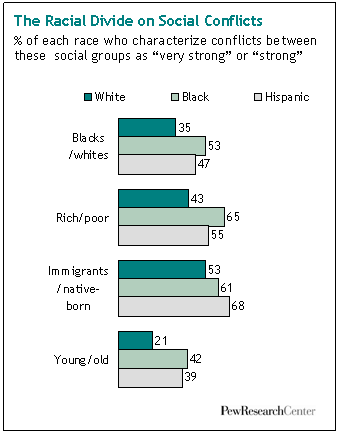
Blacks were more likely than whites to see “very strong” or “strong” conflicts in three of the four areas. In the fourth domain — disagreements between immigrants and native born — the difference also was large but fell just short of statistical significance (61%for blacks vs. 53% for whites). Nearly two-thirds (65%) of blacks but 43% of whites say major disagreements exist between rich people and poor people, a view shared by 55% of Hispanics.
The racial divide is nearly as wide on perceptions of racial conflict. A majority of blacks (53%) but slightly more than a third of whites (35%) say major conflicts exist between the two races. Hispanics also are more likely than whites to see serious disagreements between blacks and whites (47% vs. 35%).
The gap is narrowest between blacks and whites on conflicts between immigrants and the foreign born, 61% vs. 53%, an eight-point gap. But there is a 15-point gap between Hispanics (68%) and whites (53%) on this question. There is also a sizable gap in views about generational conflicts: blacks are twice as likely as whites to see major conflicts between the generations (42% vs. 21%), a view shared by 39% of Hispanics.
The Politics of Social Conflict
The issue of race has been thrust onto center-stage of American politics this summer. In July, President Obama hosted a “beer summit” at the White House to try to smooth over a controversy he helped to fuel with his comments at a press conference regarding the arrest of a black Harvard professor by a white Cambridge policeman. More recently, prominent Democrats such as former President Carter have publicly speculated that race — and, by implication, racism — is behind some of the attacks on President Obama at venues ranging from town-hall meetings to the floor of Congress. Meanwhile, Republicans accuse Democrats of playing the race card to deflect legitimate criticisms of the president’s policies.

The Pew Research survey suggests these very different views on black-white relations reflect deeper partisan and ideological differences. Nearly half of Democrats say there are “very strong conflicts” (10%) or “strong conflicts” (36%) between blacks and whites. In contrast, only about a third of Republicans say racial disputes are as serious (7% say these conflicts are “very strong” while 26% characterize them as “strong”).
At the same time, nearly six-in-ten Republicans (59%) say there are no major areas of contention between the races, a view shared by 48% of Democrats. Conservative Republicans are significantly more likely than liberal Democrats to see relatively few racial conflicts (63% vs. 50%). But their counterparts on the left — self-described liberal Democrats — are no more likely than other Democrats to say major conflicts exist between blacks and whites (48% for liberal Democrats vs. 45% for moderate or conservative Democrats).3
This partisan divide on social conflicts also exists on another issue tested in the survey. A majority of Democrats (55%) but just 38% of Republicans see serious conflicts between the rich and poor.
However, the partisan-perception gap does not extend to other areas of American life. An equal share of Republicans (57%) and Democrats (56%) say major conflicts exist between immigrants and native-born Americans. Similarly, roughly a quarter of each party believe there are major conflicts between the young and older generations.
Big Majority Sees at Least One Area of Major Social Conflicts
To provide an overview of public attitudes toward social conflicts, a simple scale was created based on the four types of conflicts measured in the survey — rich and poor, black and white, immigrants and native born and young people and older adults. The scale totaled the number of realms in which each respondent believes “very strong” or “strong conflicts’ currently exist. For example, if a respondent says very strong or strong conflicts exist in all four areas, the respondent’s score would be four. If a respondent reports no strong conflicts in response to all four questions, his or her score would be zero.
Overall, fully three-quarters of those surveyed (76%) say that serious conflicts currently exist in at least one of the four areas tested. About half (51%) report major conflicts in two or more areas.
At the same time, nearly a quarter (24%) say there are no major disputes between groups, while, at the other extreme, only about one-in-ten say there are serious conflicts in all four domains.
Blacks are more than twice as likely as whites and somewhat more likely than Hispanics to see major conflicts in three or more areas (50% for blacks vs. 24% for whites and 43% for Hispanics).
Democrats, too, are more likely than Republicans (36% vs. 22%) or political independents (26%) to see three or more areas of serious disagreement. Political liberals saw more disagreements overall than conservatives (34% vs. 26%).
The perceptions gaps are smaller among other demographic groups. Women (33%) are more likely than men (26%) to see three or more areas of serious conflict while the foreign born are more likely than people born in the U.S. to see multiple areas of disagreement (37% vs. 29%).

